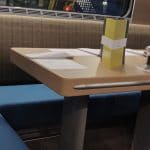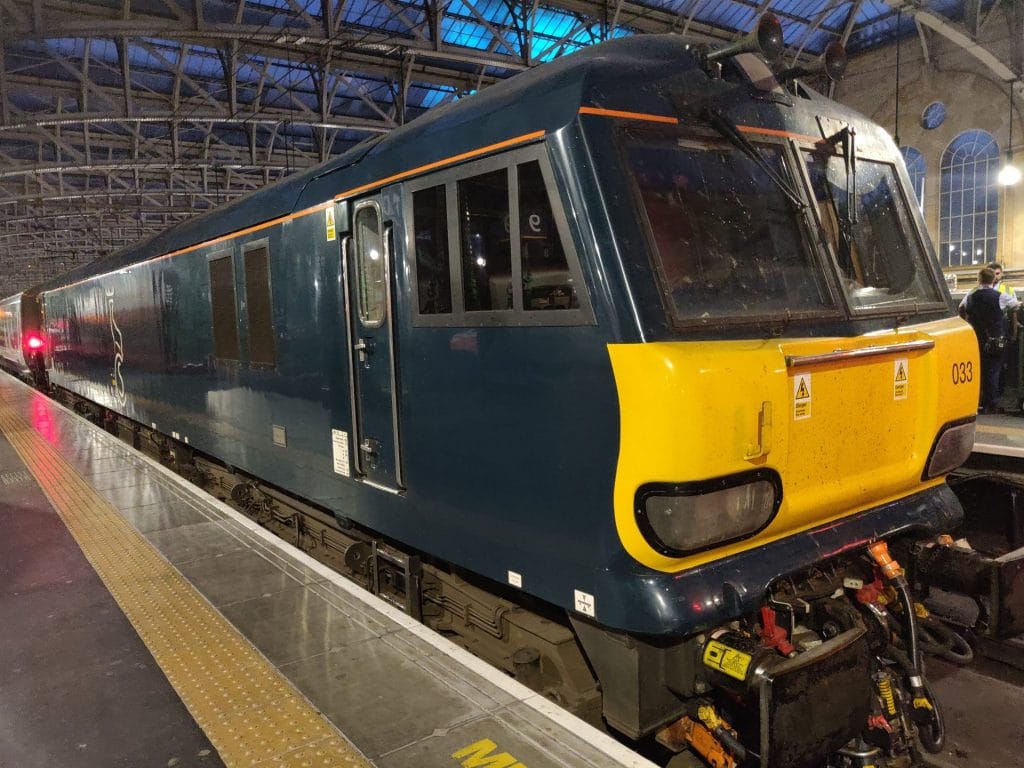
Train 1
Service: 1M11 2340 Glasgow Central to Euston
Operator: Caledonian Sleeper
Class: 92 + Mk.5
My journey
Whole route
Stats: 418.3 miles, 7 stops in 7:07 (58.8 mph)
For those who have been keeping up, it still Day 5. I’m at Glasgow Central and about to travel on the sleeper up to Euston. I travelled with my family in a sleeper cabin on a MotorRail service between Glasgow and London in 1988, and I have used sleepers several times since I started pounding the tracks in earnest in 2006. I love it on the Highland sleeper as you look out in the early morning summer light onto Loch Lomond and the Trossachs before crossing the expanses of the moors all the way to Fort William. But tonight I was on the Lowland Sleeper, which links Edinburgh and Glasgow to London. The scenery is far less dramatic but it’s still a great way to put some miles under your belt as you sleep.
The sleeper business was split off from the main ScotRail franchise in 2015 and awarded to Serco. Yes, that jack of all trades with a proud record of underachievement. What could possibly go wrong? But it could have been worse. Capita, anyone?
Serco relaunched the service in 2017 and ordered a fleet of brand new trains. Just like every other train operator. While they were being constructed Serco hired in refurbished electric and diesel locomotives to improve reliability, including the unique class 81 electric loco (mainly used to convey empty carriages) and the class 73/9s, early 1960s locomotives originally intended to live on the Southern Region of British Rail using electricity from the third rail, but now using diesel to drag sleeping passengers across the moorlands.
The new sleeper train orders were unusual in that very, very few operators run unpowered carriages these days. So far as I know, none have been delivered in Britain for almost 20 years, although there are a fair few still in use. Most passenger trains are multiple units, a fixed formation of between one and 12 carriages that are self-powered and can be combined to make longer trains. But a sleeper has different requirements. It has cabins, showers, toilets and is altogether a specialist vehicle. There’s a need for flexibility: the highland sleeper runs between London and Fort William, Aberdeen and Inverness. It needs to split into three sections en route and to pick up additional carriages for the Fort William ‘day’ cars (seated and dining accommodation), as well as do the reverse in the other direction. The demand for the three sections varies, so the train makeup has to, too. The lowland sleeper also joins/splits on the way. So a flexible setup with unpowered carriages pulled by locomotives makes sense.
The new carriages should have all been in service by now but have been plagued by teething problems. So much so that at the time of writing (September 2019) Serco has yet to introduce them on the highland sleeper, being keen to iron out the difficulties on the lowland service before they risk it. But my train is new, with shiny Mark 5 carriages and a sleek class 92 electric locomotive at the front.
I was greeted, as is usual for the sleeper, by a crew member dedicated to my part of the train, and handed my keycard. I went straight to my cabin.
Much has been made of the vastly improved interiors of the new trains compared with the old Mark 3 sleepers they’re replacing. And they do feel much more modern. The old trains had cabins that can be locked from the inside, but not the outside. The new have electronic keycards. The old trains have toilets at the ends of the carriages and showers available at stations; the new have en-suite cabins. Both have an upper berth that is tucked away when not needed.
There is now much better lighting and heating/aircon, and a better ride, although I always liked the rocking of the old carriages.
But what of the much publicised en-suite? Well, for teeth-brushing and shaving there’s still a wash-basin under a folding shelf below the window, but now you have a whole new (very small) room. It has a toilet (reducing the need for the wash basin at 3 am) with a folding shelf that covers it. The shower is, more or less, above the toilet, so it’s best used as a sitting shower. But I had hot water (unlike many this summer – that was a major problem area) and everything worked as designed.
One thing I love about the sleeper is the lounge car. The old ones had seats that were not fixed to the floor, and sofas, providing a nice, informal atmosphere. The new ones have various dining booths, stools and, of course, accommodation for passengers with wheelchairs. But comfortable and inviting.
The food? I enjoyed it. I had a Scottish gin and tonic; haggis, neeps and tatties; some wine, a selection of Scottish cheeses and a malt whisky. Like the accommodation, the prices seem to have shot up since my last trip. Is it worth it? Yes, but probably not if you have to do it often, or with a family.
One thing that hasn’t changed: I was waited on by a pleasant steward.
I left the lounge car and retired to my cabin. It was only about 2340 and the train was still in Glasgow Central, but we soon set off. I was fast asleep by the time we stopped at Carstairs to join with the Edinburgh portion before setting off down the west coast main line to the south.
I awoke some hours later and headed for the lounge car for my full Scottish. It wasn’t a patch on the old BR fry-ups, but it set me up for the day: orange juice, bacon, scrambled egg and a few other things. Importantly, tea. I watched the waking world go by: Rugby, Milton Keynes, Watford. As we passed Queens Park I want back to my cabin to check that all of my belongings, plus any portable freebies, were safely stuffed in my backpack.
So, how was the sleeper experience? Pretty good. But really, the new trains make little difference, it seems to me. It’s still the sleeper, for good (travel as you sleep, and on a train) and ill (small cabin). I like it, but some don’t.
The approach to Euston is steep, as trains pass over the Regents Canal before descending to the terminus. But gradients aren’t something a modern traveller needs to think about. Or are they? At about the time my train drew up safely to the buffer stops in Euston, the Edinburgh section of the down sleeper was approaching Waverley, also down a hill. The driver applied the brakes and promptly suffered a Caledonian brownout as the train failed to slow as quickly as it should have done. It overshot the station by 700 yards. Luckily it was a through platform and there were no trains or other obstacles in the overrrun, but imagine if it had happened at Euston. The train only stopped when it did because the guard had the presence of mind to apply the train brakes. The initial enquiry suggests that a valve on the train brake pipe was left closed when the train was split at Carstairs, leaving the driver with brakes on the engine only, with no braking available to him/her from the rest of the train. Every train journey is supposed to include static and running brake tests to make sure that the brakes are working properly, so something went seriously wrong that night.
But I knew nothing of this potential disaster as I stepped into early-morning London. So where to?
Train 2
Service: 9T83 0622 Bedford to Gatwick Airport
Operator: Thameslink
Class: 700
My journey
St. Pancras International to Gatwick Airport
Stats: 29.7 miles, 6 stops in 0:47 (38 mph)
Train 3
Service: 1W20 0730 Gatwick Airport to Brighton
Operator: Southern (Gatwick Express)
Class: 387
My journey
Gatwick Airport to Brighton
Stats: 24 miles, 1 stop in 0:20 (72.1 mph)
I’ve got this thing about unusual journeys; those remnants of old timetables that hang around for no reason that I can fathom. Until not so long ago the first Cambridge to Birmingham train used to continue all the way to Aberystwyth. Some early trains from Redcar go all the way to Carlisle. Some journeys from Newcastle used to carry on to Stranraer. I like just settling in to these oddities and sticking my nose against the window. So I’d be travelling on GWR today. This train company operates almost all of the services from Paddington to the southwest and south Wales as well as many local and regional services in the west of England. But I’d be catching my GWR service from Brighton. I think there was once a regular service between Brighton and places such as Cardiff. So far as Brighton is concerned there’s now just one or two trains a day, my one going to Great Malvern. And I intended to be on it.
I could have caught the Victoria Line and then a Southern service to Brighton, but chose to walk to St. Pancras and travel by Thameslink. I didn’t have long to wait long before a Gatwick service arrived. I can’t remember if I found the first-class seats any better than the rock-hard standard class seats on this class 700, but I wasn’t on the train for long. I alighted at Gatwick with quite a few others, although only a few percent of the capacity of this fixed-formation 12-car train.
I hurried to another platform to catch an onward connection to Brighton. It arrived in the form of a Gatwick Express class 387. Not very different from the class 379 units on the Stansted route, so of little interest to me as a train. But the journey south was interesting enough and I arrived at Brighton just before 8.30. I grabbed coffee then went back through the barrier to wait on platform 1 for a dark green train to appear.
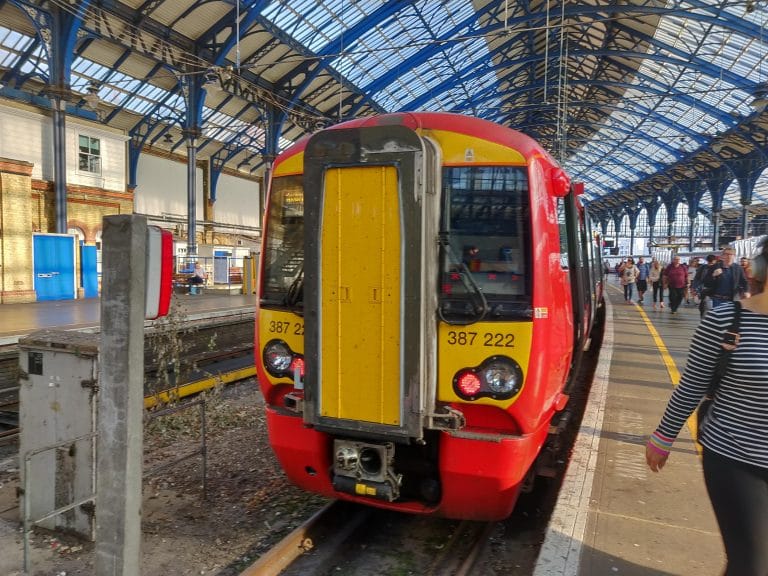
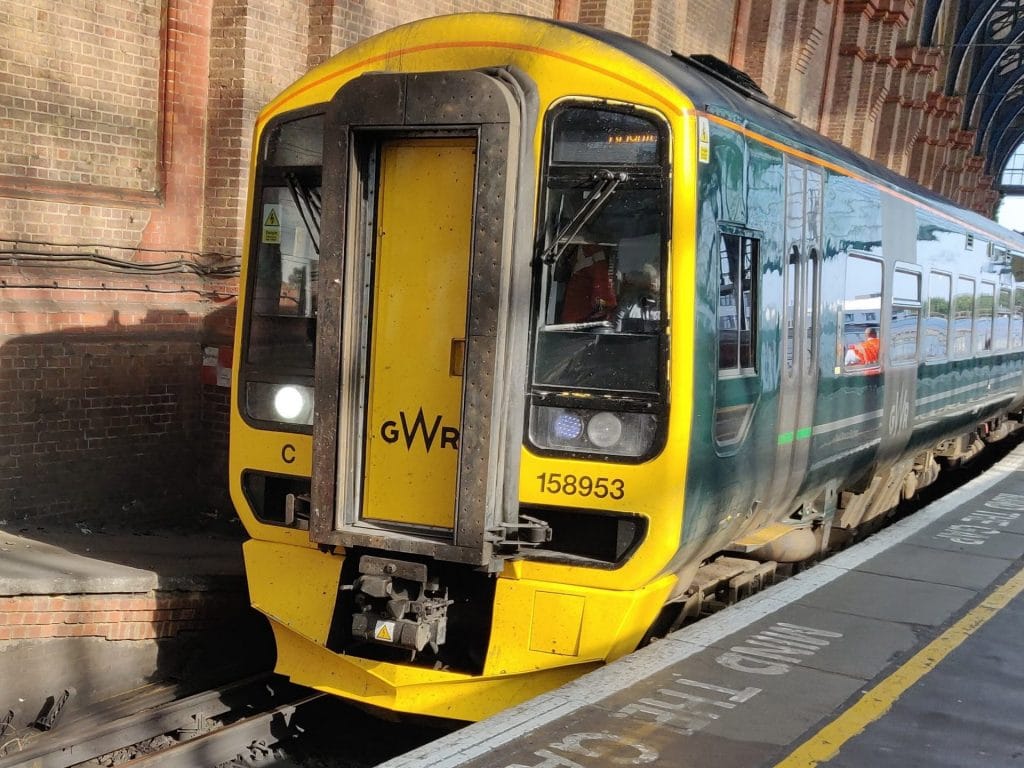
Train 4
Service: 1V94 0559 Brighton to Great Malvern
Operator: GWR
Class: 158
My journey
Brighton to Westbury
Stats: 111.1 miles, 13 stops in 2:43 (40.9 mph)
As I waited at Brighton for my GWR service I was joined by a few others, then a flood of people as the train arrived and the station indicators announced its departure platform. We were not allowed on board until it was almost time to depart, and then all hell broke loose.
Almost every seat had a paper seat reservation label. People were walking up and down looking for either their own or an unreserved seat. I grabbed the first window seat I could and settled down for a fairly long ride.
This was another class 158 Super Sprinter. They’re not bad trains at all. They have standard class only and are used for just this type of service, fairly fast regional services. The only thing wrong with it was that it was just three coaches long and could have done with another three.
We set off along the West Coastway line. This was on the list of lines I wanted to use. I’d been put off by hearing that many trains on the line are operated by old class 313 trains cascaded from London Overground. I don’t like class 313 trains, but could cope with them except they lack toilets. I hear that they don’t tend to be used on trains running the full length of the Coastway, to Portsmouth, and I was on a train that definitely had working toilets. Just as well, as I was at least four hot drinks down already.
We passed through Hove, Worthing and Chichester, passing junctions for spurs to Littlehampton and Bognor Regis. There were plenty of glimpses of sea, to my satisfaction. After Havant we veered inland, avoiding Portsmouth, and continued to Southampton, Salisbury and Westbury. The line between Southampton and Salisbury was another on my to-do list.
My train had been packed since Brighton, and quite a few passengers had travelled all the way so far. Many now got off at Westbury to change onto trains to the west country. I did the same. I’d travelled on trains between here and Bristol before, and they were just as busy as the one I’d just left. Definitely yet another capacity problem.
Train 5
Service: 1C33 1033 Paddington to Paignton
Operator: GWR
Class: 800
My journey
Westbury to Paignton
Stats: 106.2 miles, 8 stops in 1:50 (57.9 mph)
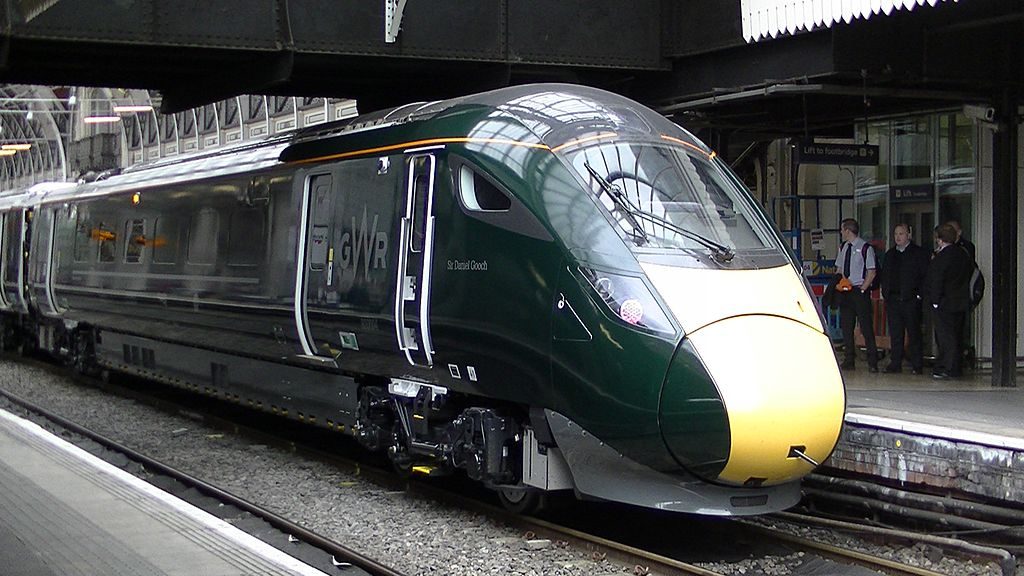
My next train had come from Paddington and was going to Paignton. Being a summer’s day during the school holidays it was busy, but relatively peaceful in first. It was, of course, a rock-seated class 800, the old InterCity 125s having recently been retired by GWR with an excess of hype (can you have an excess of hype? Isn’t hype, by definition, excessive?).
I’ve travelled between Westbury and Newton Abbot before, but just after Exeter is one of the country’s best stretches of rail, along the coast through Dawlish. The journey is always a joy. Beyond Newton Abbot we took the the branch through Torquay to Paignton, arriving in platform 1. Yet another to-do crossed off.
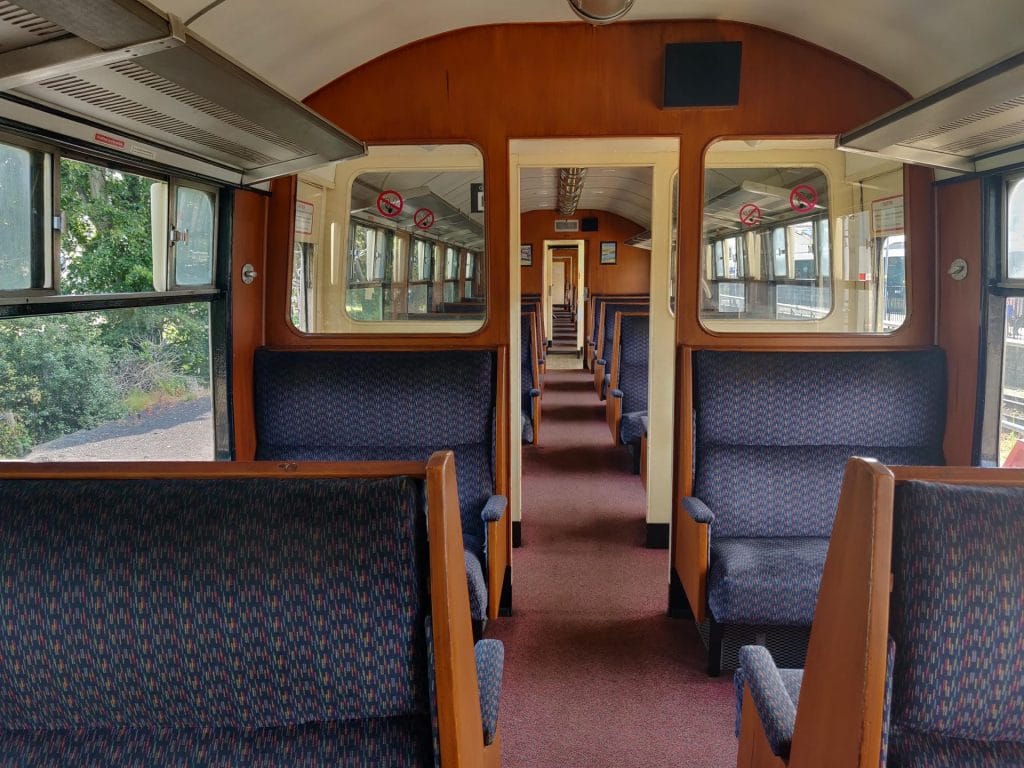
Train 6
Service: 1415 Paignton to Kingswear
Operator: Dart Steam Railway
Class: Steam engine + Br. Mk. 1s
My journey
Whole route
Stats: 6.7 miles, 4 stops in 0:30 (13.4 mph)
Train 7
Service: 1455 Kingswear to Paignton
Operator: Dart Steam Railway
Class: Steam engine + Br. Mk. 1s
My journey
Whole route
Stats: 6.7 miles, 3 stops in 0:29 (11.5 mph)
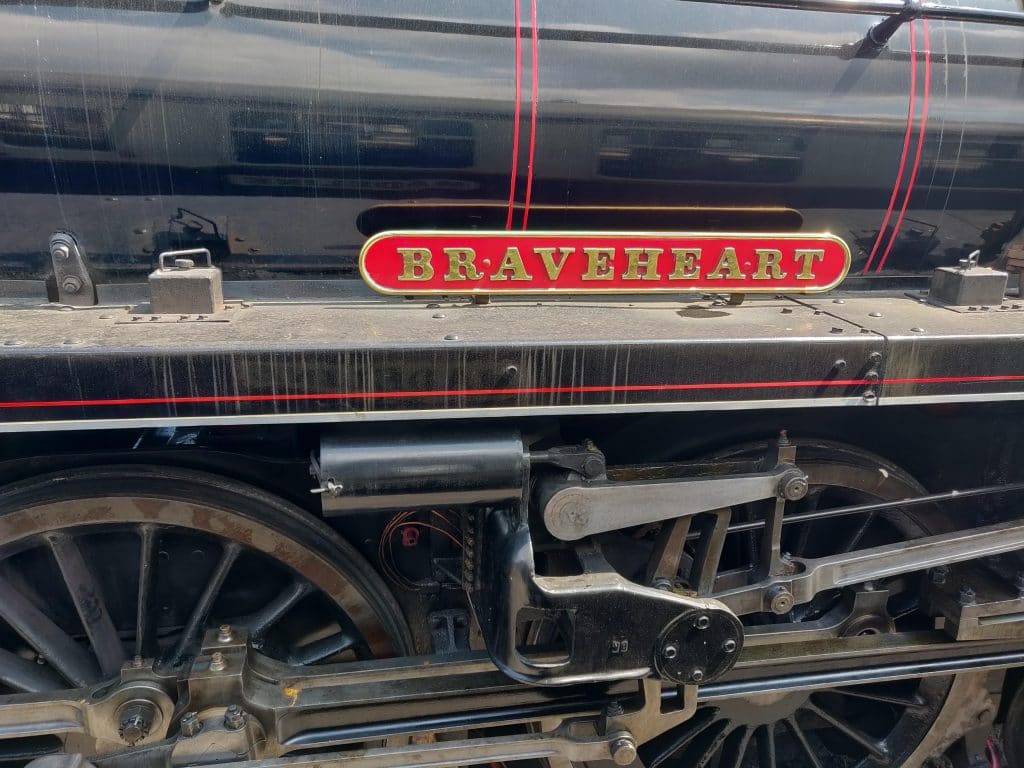
So far as the national rail network is concerned I have reached the end of the line, yet the tracks continue beyond the station and over a level crossing. They lead to Goodrington Carriage Sidings and the private Dart Steam Railway. Once, Paignton was a station on a through line. Now it’s the terminus. But the line was truncated on the cheap. A train in platform 1, the platform I’d just arrived in, cannot return towards Newton Abbot as there isn’t a way for it to cross to the up line. Most trains serving Paignton are local, having come from Newton Abbot, Exeter or Exmouth, and they arrive on platform 2, from where they can reverse. The few long-distance trains that serve Paignton from Paddington or the CrossCountry network use platform 1 then cross the level crossing to Goodrington, where they can be prepared for the return journey before crossing back to platform 2.
I waited for my train to pass over the level crossing towards the sidings then walked to the adjacent Dart Steam Railway station. I don’t travel very much on heritage railways, but this is a nice part of the country and I have time to kill. And, it seems, there’s a train due quite soon. I bought my ticket and went onto the platform.
There was a train waiting, consisting of a long rake of British Rail Mk. I coaches in the old Great Western chocolate and cream livery. The train was very far from busy. Yes, it was midweek, but it was school holidays. On an adjacent track an engine was moving. It was called Braveheart and Google tells me that it’s a British Railways Standard class 4 and that it used to work on the steam-hauled Jacobite service between Fort William and Mallaig.
I didn’t know what was on the front of my train, but it worked, because we were moving. A small number of other people had now joined me in a carriage which was very familiar to me, being identical to those that worked between Cambridge and Liverpool St. not so long ago (or so it seems to me) but which must seem prehistoric to the younger passengers.
Yet again I was on a train following a scenic coast. The sea was bright blue, there were wide, sandy beaches full of people enjoying the sun and there were palm trees as the train continued along the coast to the River Dart estuary at Kingswear. The train terminated here and many got off to catch the ferry to Dartmouth or the paddle steamer Kingswear Castle. Even more got on for the trip back to Paignton.
As we waited for the departure time our engine ran around its train. It was a Manor class, build in Swindon in around 1950 by British Railways but of impeccable GWR heritage. I’m not sure which particular loco it was, as I saw both Lydham Manor (7827) and Dinmore Manor (7820) in steam, the latter being on loan to the railway at the time.
30 minutes later I was back in Paignton.

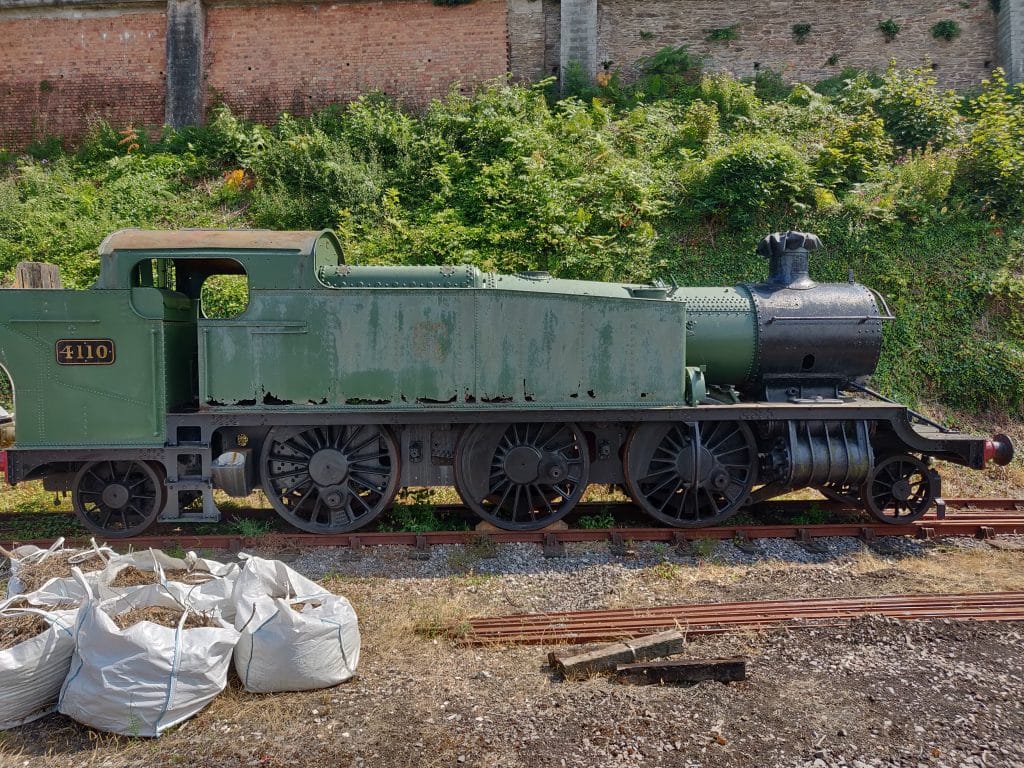


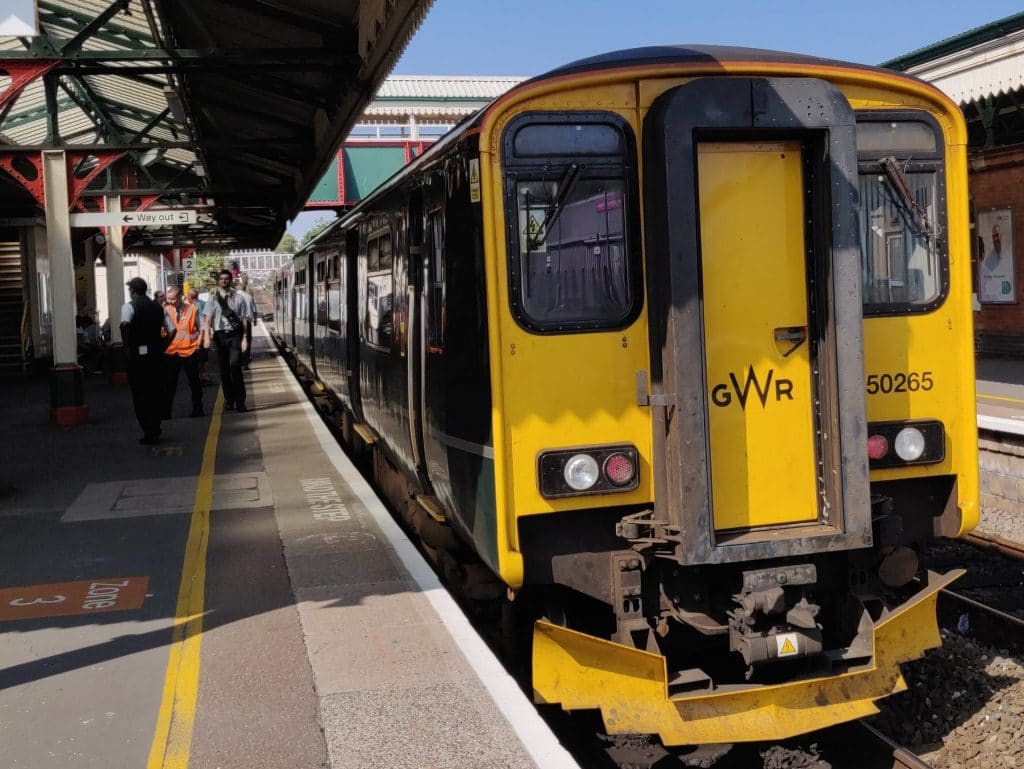
Train 8
Service: 2E44 1629 Paignton to Exeter St. David’s
Operator: GWR
Class: 150 (150265)
My journey
Paignton to Newton Abbot
Stats: 8.1 miles, 3 stops in 0:15 (32.4 mph)
Train 9
Service: 1E67 1625 Plymouth to Leeds
Operator: CrossCountry
Class: 220/221
My journey
Newton Abbot to Exeter St. David’s
Stats: 19.2 miles, 1 stop in 0:18 (64.1 mph)

After a wander around Paignton I pondered my next actions. I was between hotels so had a full backpack. While I was in this neck of the woods I’d like to travel on the Exmouth line, or perhaps the Bristol Temple Meads to Severn Beach branch. In any case I needed to head out of Paignton and towards Newton Abbot, so I settled down on platform 2 and waited for a train.
It arrived in the form of a GWR class 150 bound for Exeter St. David’s. It’s one of the modified class 150s that only GWR operate, where they’ve split two-car units to form three-car trains with a landlocked driving cab at one end of the middle coach. The seating is quite dense, and these units are only capable of 75mph, so they’re not suitable for anything other than local or commuter work, but they’re not too bad, most of the time.
As we left Paignton I was on the coastal side of the train, and had more pleasant views as we travelled past Torquay before we turned inland towards Newton Abbot.
I could have stayed on the class 150 to Exeter but had decided to go straight to a hotel in Bristol. I got off at Newton Abbot to await a CrossCountry service. This had come from Plymouth and was going all the way to Leeds and might be busy, so I reserved myself a seat. If the seat was occupied then I wouldn’t turf the occupant out of it unless I had nowhere else to sit.
I really hate this system.
I caught the train and found my seat to be empty, so settled down for the almost 100 miles to Bristol. But something didn’t seem right. What was it? I was on a Voyager, and it didn’t smell unpleasant. But neither did the one in Scotland on Saturday. Maybe they’ve fixed that particular problem? So what was troubling me?
I know! As well as a backpack I was travelling with a light rainproof coat, but now I didn’t have it. I’d had it with me at Paignton, so where was it? Probably on that GWR class 150.
I tried tweeting @gwrhelp. I was told to complete a form giving a full description of the item and where I’d last seen it. Having provided GWR with all that information they referred me to a web page in which I could fill in the details all over again. Bloody useless. But I had an idea.
Train 10
Service: 1L68 1725 Exeter St. David’s to Waterloo
Operator: SWR
Class: 159
My journey
Exeter St. David’s to Exeter Central
Stats: 0.8 miles, 1 stops in 0:03 (15.5 mph)
Train 11
Service: 2T25 1746 Exeter Central to Exeter St. David’s
Operator: GWR
Class: 150 (150265)
My journey
Exeter Central to Exeter St. David’s
Stats: 0.8 miles, 1 stops in 0:02 (23.5 mph)
I checked Realtimetrains to see what happened to the train I’d been travelling on and my plan fell into place. It would be tricky. I got off the Voyager at Exeter St. David’s and ran through the subway, leaping through the gap in the closing doors and making a one-minute connection with a Southwestern Railway class 159 bound for London Waterloo. I stood inside the doors for the 62 chain journey to Exeter Central. I crossed to the opposite platform and waited. After a few minutes the train carrying my coat (I hoped) passed through without stopping on the other side. I knew it would. After terminating in St. David’s it had drawn forward into Exeter New Yard before emerging a few minutes later as empty coaching stock, passing through Exeter Central to Exmouth Junction, where it would reverse again and come back for me.
The platform was busy until a late-running arrival from Honiton picked up the passengers that were only going to, or changing trains at, St. David’s. The empty train should have arrived by now. Next was a train from London, then one from Exmouth. Finally, nearly a quarter of an hour late, the Paignton service arrived. I was only travelling a mile so stood back to allow the commuters to take the seats. Once they were settled I reached up to the luggage rack and retrieved my coat. Job done.
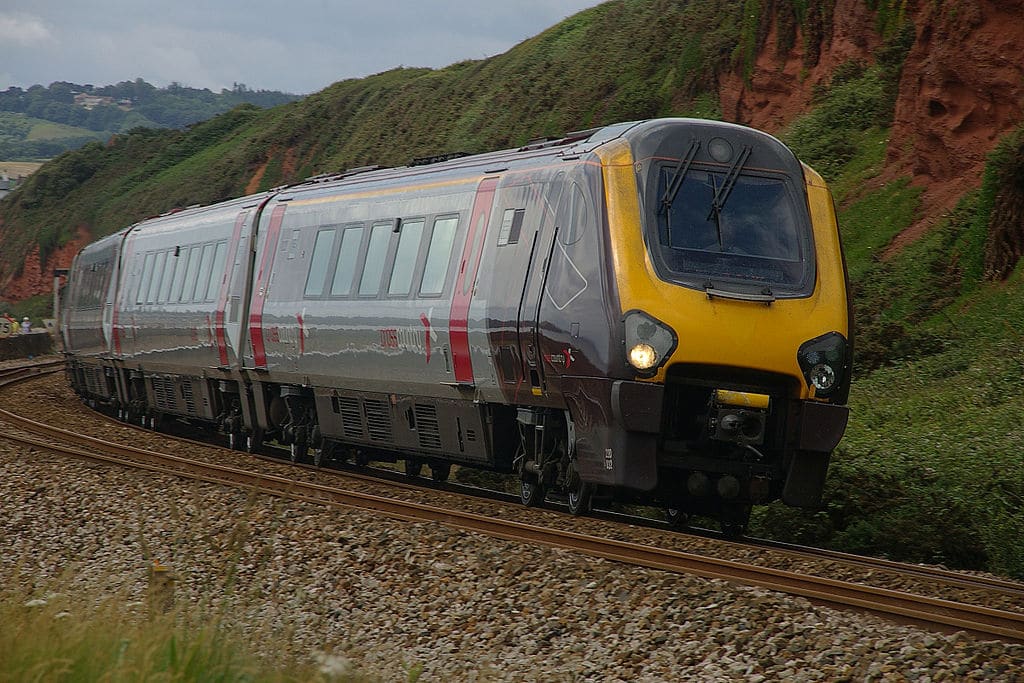
Train 12
Service: 1E73 1725 Plymouth to Leeds
Operator: CrossCountry
Class: 220/221
My journey
Exeter to Bristol
Stats: 75.5 miles, 1 stop in 1:05 (69.7 mph)
Back at St. David’s I caught the next Bristol service, another CrossCountry Voyager going to Leeds. Once again I reserved a precautionary seat. And that was it. Had I not had to do the lost coat shuffle I would have ridden to Severn Beach and back. As it was I went to my nearby hotel.
Well, I started the day in Glasgow and have now reached Bristol via the south coast and a steam train ride on the ‘English Riviera’. I’ve used lines I wanted to visit and have seen great scenery, and more of the (mostly) good and bad of today’s railway. And I didn’t lose my coat.
Today was a good way to end my tour. Tomorrow I’ll go home, but not in straight line.
The duplicate image above isn’t a mistake. This the same journey as train 9, interrupted by the coat saga.

